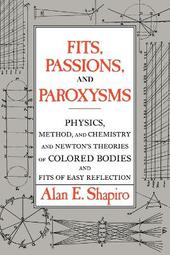
|
Fits, Passions and Paroxysms: Physics, Method and Chemistry and Newton's Theories of Colored Bodies and Fits of Easy Reflection
Paperback / softback
Main Details
| Title |
Fits, Passions and Paroxysms: Physics, Method and Chemistry and Newton's Theories of Colored Bodies and Fits of Easy Reflection
|
| Authors and Contributors |
By (author) Alan E. Shapiro
|
| Physical Properties |
| Format:Paperback / softback | | Pages:420 | | Dimensions(mm): Height 229,Width 152 |
|
| Category/Genre | Philosophy of science |
|---|
| ISBN/Barcode |
9780521117555
|
| Classifications | Dewey:501 |
|---|
| Audience | | Professional & Vocational | |
|---|
| Illustrations |
Worked examples or Exercises
|
|
Publishing Details |
| Publisher |
Cambridge University Press
|
| Imprint |
Cambridge University Press
|
| Publication Date |
30 July 2009 |
| Publication Country |
United Kingdom
|
Description
Building upon his pioneering investigation of the colours of thin films, Isaac Newton developed two influential theories, one on the structure of matter, explaining the colours of bodies and the other on fits, describing the periodicity of light. Professor Alan Shapiro, editor of The Optical Papers of Isaac Newton, recounts the development of these theories based on his study of Newton's unpublished manuscripts and analyses their experimental foundation. He also shows the essential role that Newton's philosophy of science played in the formulation and reception of these theories. The second part of the book describes a vigourous dispute over Newton's theory of coloured bodies waged by physicists and chemists for nearly fifty years, from the late eighteenth century to the early nineteenth century. Professor Shapiro's analysis of this previously unknown dispute and of the reasons for the chemist's attack on Newton's theory illuminates the nature and relation of physics and chemistry during this seminal period of their development.
Reviews..".an impressive examination of the dispute over Newton's mathematical and corpuscular explanationof light transmission for the next two centuries...this book is such a display of scholarship and formidable analysis of archival sources that it might serve as a model for the refraction of an idea over two centuries." Larry Stewart, Albion
|